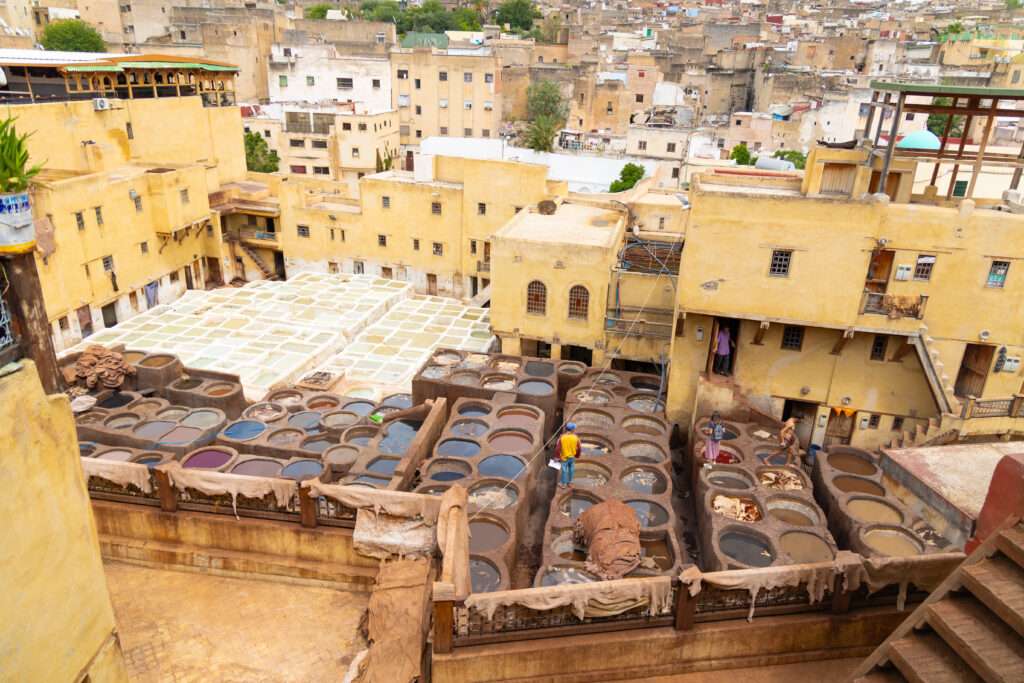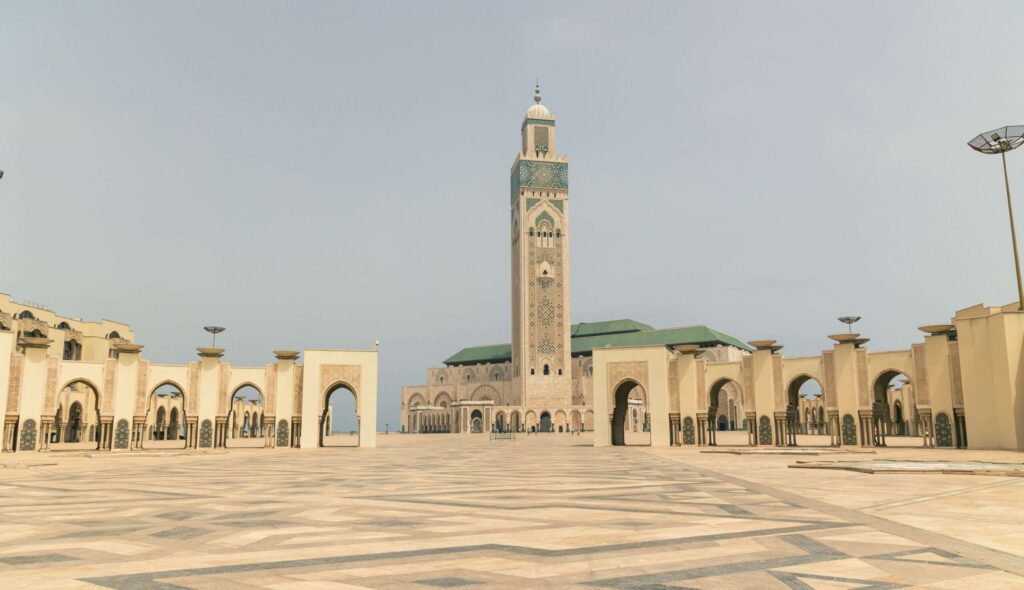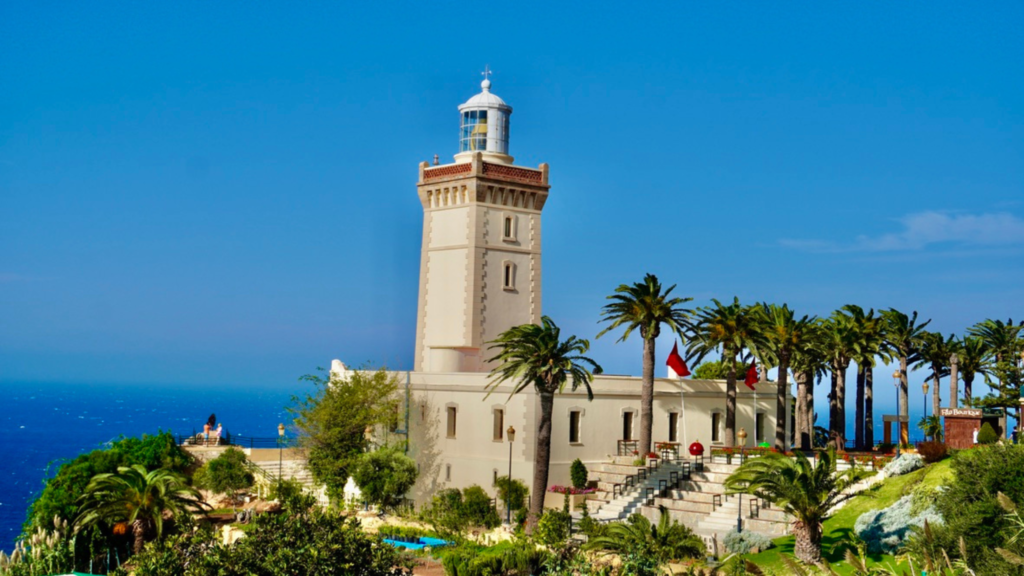Introduction
Planning a trip and wondering about the best things to do in Morocco? This beautiful North African country is full of history, culture, and adventure. In this blog post, you will learn about the four major regions for tourism in Morocco, including Marrakech, Casablanca, Fez, and Tangier. From colorful cities and lively markets to coastal views, historic landmarks, and desert landscapes, Morocco offers something unforgettable for every traveler.
1-Things to Do in and Around Marrakech

Marrakech is one of the most exciting cities in Morocco and a must when planning your trip. Known as the Red City because of the clay color used in building the old houses of the medina, its name comes from an Amazigh term meaning “Land of God.” It was founded by nomadic tribes looking for water and grazing land, and from then on its history has been full of remarkable events that you can still feel today.
At the heart of the city is Jemaa el-Fna Square, famous for its storytellers, musicians, henna artists, and, less pleasantly, snake charmers. You can also step back in time at the Ben Youssef Madrasa, the Bahia Palace, and the El Badi Palace.
Marrakech is also known for its gardens, created as a retreat from the city’s intense summer heat. Some of the most beautiful are the Majorelle Garden near the YSL Museum, the Secret Garden, and the Anima Garden. Even public gardens like Arset Moulay Abdeslam offer shade and free Wi-Fi.
If you like museums, you’ll find plenty: the Photography Museum, Dar Si Said Museum, and smaller private collections. For a glimpse into Jewish heritage, visit the Mellah (Jewish Quarter). The city also has a church downtown, making Marrakech a place where different religions have coexisted for centuries.
The medina itself is an adventure: markets full of spices, carpets, ceramics, and lanterns, alongside rooftop restaurants and bars with sweeping views.
Day Trips from Marrakech
Imlil Valley – the “Kathmandu of Morocco”
Just 90 minutes away, this valley is the starting point for treks into the High Atlas Mountains, including the climb to Mount Toubkal (4,167m), the highest peak in North Africa. That’s why Imlil is often called the Kathmandu of Morocco. You’ll find everything from gentle valley walks for families to challenging multi-day hikes for seasoned trekkers. Villages here offer warm hospitality, and sharing a meal with a local family or at a mountain auberge is an experience that adds a real touch of authenticity.
Ouzoud Waterfalls – Boat Tour & Family Experience Highlight
Among the tallest waterfalls in Africa at 110 meters, Ouzoud Waterfalls feel like a hidden paradise. From above, you can see the cascades right next to the parking area, but exploring further means walking down steep trails or stairways—good shoes are essential. You can take a short boat ride close to the falls, feel the spray on your face, and enjoy the lush scenery.
A family-owned restaurant near the falls offers a traditional meal that you won’t find on standard Moroccan menus. It’s prepared just for you, making it a unique experience. Staying overnight nearby makes the visit more relaxed and rewarding.
Ait Ben Haddou and Ouarzazate
A UNESCO World Heritage Site, Ait Ben Haddou is a mudbrick ksar that once hosted traders crossing the desert. Few families live here now, but many homes have been turned into guesthouses or shops. Stop at Tawesna, a women-run tea house, and visit Akhnif Leglaoui, a sustainable rug cooperative. Here, women from arid regions—many of whom never had formal schooling—use life-taught skills in weaving and design to earn income and preserve their traditions. Supporting their work is supporting their independence.
Nearby Ouarzazate is Morocco’s film capital, known as “Mollywood.” Tour the Taourirt Kasbah, the Cinema Museum, and studios where movies like Gladiator and series like Game of Thrones were filmed.
Essaouira – the “well-designed” city
About three hours from Marrakech, Essaouira is a coastal town built in a grid layout, unusual for Morocco. Its medina is small, lively, and easy to explore. Visit the Skala de la Ville with its old cannons, stroll through the souks, and watch fishermen at the port. You can buy seafood and have it cooked for you at a stall, or enjoy ocean-view restaurants like La Table by Madada or Salut Maroc. For a more authentic taste, try a family-owned restaurant where the food is fresh, simple, and unforgettable—their salads with argan oil and daily fish dishes are a highlight.
If you stay overnight, you’ll have time to enjoy activities like horse riding along the beach, surfing, kite surfing, cooking classes, hammams, or simply walking at sunset.
Agafay Desert – Not Sand Dunes
Only 45 minutes away, the Agafay Desert is a rocky landscape—not dunes, but a quick escape for camel rides, quad biking, or glamping. Choose your camp carefully; some sit too close to the road. It’s best for travelers who don’t have time to reach the Sahara.
Sahara Desert Tours
For the true golden sand dunes, plan at least a 4- or 5-day Sahara desert tour from Marrakech. Shorter tours mean long drives and rushed stops. The most stunning dunes are at Erg Chebbi and Erg Chigaga. Along the way you’ll pass Ait Ben Haddou, Ouarzazate, Valleys of thousand kasbahs, Rose Valley, underground irrigation channels, and palm oases.
Experiences in Marrakech
Beyond sightseeing, Marrakech offers plenty of hands-on activities:
- Cooking classes in riads or women’s cooperatives
- Hot air balloon rides at sunrise
- Cycling through the palm groves
- ATV adventures in the countryside
- Guided city tours with a mix of history, monuments, and shopping
2-Things to Do in and Around Fes

If you are looking for cultural things to do in Morocco, Fes is the place. Its old medina is a UNESCO World Heritage Site with narrow streets, traditional markets, and the famous leather tanneries. Known as the cultural heart of Morocco, Fes is also considered the spiritual capital and the gastronomic capital of the country. It is the hometown of the oldest university in the world, founded by a woman named Fatima al-Fihria.
Exploring Fes requires some stamina, as the city has many changes in elevation, with steep up-and-down alleys and plenty of steps. But every corner reveals history, craftsmanship, and vibrant local life.
Day Trips from Fes
Middle Atlas Mountains & Cedar Forest
Just outside Fes, you can take a day trip into the Middle Atlas Mountains. During winter (December–February), this region is nicknamed the “Switzerland of Morocco” thanks to its snow-covered landscapes, alpine-style architecture, and ski resorts that resemble the Alps. You’ll also find cedar forests, home to Barbary macaques, and stunning mountain scenery year-round.
Volubilis & Meknes
A must-do cultural day trip combines Volubilis and Meknes. Volubilis was once the capital of the Roman province of Mauretania Tingitana, and today you can still admire its beautifully preserved mosaics and city layout from ongoing excavations.
Nearby Meknes was once Morocco’s capital under Sultan Moulay Ismail, of the same dynasty still ruling Morocco today. The city boasts monumental walls, massive horse stables, a granary, and impressive water reservoirs. Highlights include the Mausoleum of Moulay Ismail, the Bou Inania Madrasa, and the bustling El Hedim Square near the iconic Bab Mansour Gate. Don’t miss tasting a camel burger or simply soaking in the lively evening atmosphere. Meknes also hosts the International Agricultural Show, one of the country’s most important annual events.
Sefrou & Bhalil (Jewish Heritage)
A lesser-known but fascinating excursion takes you to Sefrou and Bhalil, towns rich in Jewish heritage. Sefrou once had a significant Jewish community, and its annual Cherry Festival was a symbol of coexistence between Jewish and Muslim residents. In Bhalil, you can see unique cave dwellings and traces of Jewish life that testify to centuries of cultural blending in the region.
Chefchaouen (The Blue Pearl)
A longer day trip option is Chefchaouen, about 8 hours round-trip by road. The drive takes you through the Rif Mountains, dotted with lakes formed by rainfall and snowmelt. Once in Chefchaouen, you can wander its peaceful blue-and-white-washed alleys, a photographer’s dream. Be prepared with good walking shoes, as the town has plenty of stairs and steep lanes.
Despite the distance, the serene atmosphere makes the journey worthwhile.
3 -Things to Do in Casablanca and Around

Casablanca, locally known as Anfa and in Arabic as Addar Al Baida (“The White House”), is Morocco’s largest city and economic hub. For most travelers, it’s best seen as a short stopover, unless your trip involves business. One night is enough to explore the city’s highlights, including the Hassan II Mosque, the Corniche, the Central Market, and United Nations Square. While it blends modern life with a touch of tradition, Casablanca is more about urban energy than extended sightseeing
Quick Facts about Casablanca:
- Indigenous name: Anfa (“bright moisture”).
- Portuguese name: Casabranca, later adapted to Casablanca.
- Largest city in Morocco and the country’s business hub.
- Home to the Hassan II Mosque, one of the largest in the world.
- Famous for its Art Deco architecture and modern skyscrapers.
- Known for its Corniche seafront and lively nightlife scene.
Why Visit Casablanca?
Casablanca is more than just Morocco’s commercial capital—it’s the country’s international gateway, making it an ideal starting or ending point for your trip. The city blends historic charm with modern energy: colonial boulevards, buzzing nightlife, oceanfront promenades, and world-class dining.
⚠️ When to Avoid: The city can get hectic during major sporting events, especially football matches. If you’re near the stadium on game day, expect heavy traffic and crowds.
Top Things to Do in Casablanca:
1- Visit the Hassan II Mosque
No trip to Casablanca is complete without seeing the Hassan II Mosque, an architectural masterpiece that stretches partly over the Atlantic Ocean. With space for 105,000 worshippers, it’s one of the largest mosques in the world. The interior features marble columns, chandeliers, hand-carved wood, mosaics, and even a retractable roof.
- Entry fee: 140 MAD per person (includes museum).
- Guided tours are scheduled—check the official website in advance.
2. Walk Along the Corniche
For a taste of Casablanca’s modern lifestyle, head to the Ain Diab Corniche. This seafront boulevard is lined with cafés, international restaurants, and upscale clubs. While Casablanca’s beaches are more for strolling than swimming, the Corniche is the place to enjoy ocean views and nightlife.
3. Explore the Old Medina
Casablanca’s old medina is smaller than those in Fez or Marrakech, but it’s still worth a wander. Tucked behind the city’s modern façade, you’ll find narrow alleys, small shops, and traditional markets. For the best experience, explore with a licensed guide and stay aware of your belongings
4. Experience Downtown Modern Life
Casablanca’s downtown reflects its reputation as Morocco’s business hub. You’ll find wide boulevards, Art Deco buildings, modern malls, and skyscrapers. For a panoramic view of the city and ocean, visit the Kenzi Tower Hotel’s Sky 28 restaurant on the upper floors.
Good to Know:
- How long to stay: Casablanca works best as a 1–2 day stopover.
- Best for: Travelers interested in a mix of modern Morocco and cultural highlights.
- Travel tip: Use Casablanca as a base for easy day trips to nearby cities.
Day Trips from Casablanca:
Rabat – Morocco’s Capital:
Rabat is just about an hour from Casablanca and is Morocco’s political and royal capital. The city is calm and easy to explore. You can visit the Royal Palace courtyard with a guide and see the Hassan Tower, an impressive unfinished mosque from the 12th century. The Oudaya Kasbah is a charming old neighborhood with blue and white walls and views of the Bou Regreg River. Don’t miss the Mausoleum of Mohamed V where the royal family rests. After sightseeing, there are many cafes and restaurants along the marina and main avenues to enjoy Moroccan and international dishes.
Marrakech – The Red City:
Marrakech is a two-and-a-half-hour train ride from Casablanca. It is famous for its vibrant markets and historic sites. You can start at Jemaa el-Fna square to experience street performers, musicians, and local food. Visit the Bahia Palace, Ben Youssef Madrasa, and the old city walls. The city has beautiful gardens such as Majorelle Garden and Anima Garden. Marrakech also has interesting museums, small alleys in the medina, and rooftop restaurants with views of the city.
El Jadida – Coastal Charm
El Jadida is an hour south of Casablanca and is a small city with a mix of Moroccan and Portuguese architecture. Its old town, a UNESCO World Heritage site, has narrow streets, a Portuguese cistern, and historic buildings. The coastal town is also known for fresh seafood and calm beaches. Walking through El Jadida gives you a sense of history and the seaside atmosphere without the crowds.
4 -Things to Do in and Around Tangier

Tangier, located at the northern tip of Morocco where the Atlantic meets the Mediterranean, is a vibrant city full of history, culture, and coastal beauty. Known for its lively medina, colorful streets, historic Kasbah, and scenic Corniche, Tangier is a place where Europe and Africa seem to meet. The city has inspired writers, artists, and travelers for decades. From Tangier, you can also take day trips to nearby towns like Tetouan, Asilah, and Chefchaouen, or even cross to Spain, making it the perfect base to explore northern Morocco.
Quick Facts about Tangier:
- Located on the Strait of Gibraltar.
- Known as the “Gateway to Africa.”
- Has a rich mix of Moroccan, European, and Mediterranean influences.
- Famous for its Kasbah, medina, and vibrant port.
- Ideal for short stays and day trips to nearby towns.
Why Visit Tangier?
Tangier is perfect for travelers looking to explore Moroccan culture with a Mediterranean twist. The city combines historic charm, bustling markets, and scenic ocean views. Most visitors find 1 to 2 days enough to see the highlights before taking day trips to nearby gems.
Top Things to Do in Tangier :
1. Explore the Kasbah
The Kasbah is the historic heart of Tangier. Wander its narrow streets and enjoy stunning views of the Strait of Gibraltar from the Kasbah Museum. The old fortress and traditional houses show Tangier’s long history and mix of cultures.
2. Walk Through the Medina
Tangier’s medina is a lively maze of markets, cafes, and artisan shops. You can buy carpets, ceramics, and local crafts while enjoying the city’s colorful streets. Hiring a local guide can make the experience smoother and more insightful.
3. Visit the Caves of Hercules
A short drive from the city center, the Caves of Hercules are famous for their natural formations and legends. The cave opening that faces the Atlantic looks like the map of Africa and makes for great photos.
4. Stroll Along the Corniche
Tangier’s seafront Corniche is perfect for walking, dining, or relaxing with views of both the Atlantic and the Mediterranean. Cafes and restaurants offer fresh seafood and a chance to enjoy local life by the water.
5. Check Out the Grand Socco and Petit Socco
The Grand Socco is a busy square connecting the new city with the medina, full of shops and cafes. Petit Socco is smaller and quieter, with charming cafes that feel like stepping back in time.
Day Trips from Tangier
1- Tetouan
Tetouan is about an hour from Tangier. Its medina is a UNESCO World Heritage site with Andalusian architecture, small artisan shops, and peaceful streets. It’s perfect for a cultural day trip to see the traditional Moroccan life.
2- Asilah
Asilah is a coastal town known for its white-washed walls and colorful murals. The town is calm, artistic, and perfect for strolling along the beach or through the old city. Seasonal festivals make it even more lively.
3- Roman Ruins of Lixus
The ancient city of Lixus, near Larache, offers Roman ruins with breathtaking views over the Loukkos River. Explore mosaics, temples, and remnants of a civilization that thrived over 2,000 years ago.
4- Chefchaouen – The Blue City
Chefchaouen is famous for its blue-painted streets and charming medina. Located in the Rif Mountains, it’s ideal for photography, wandering, and buying local handicrafts. Spending a day here gives a peaceful contrast to Tangier’s busy streets.
5- Spain
From Tangier, it’s possible to take a ferry across the Strait of Gibraltar to Tarifa or Algeciras in Spain. Day trips to southern Spain allow you to experience a different culture just a short ride away. Ferries run frequently and make it easy for travelers looking to add an international twist to their Moroccan journey.
Conclusion
Morocco is full of amazing experiences. From the souks and gardens of Marrakech to the medina of Fez, the streets and Corniche of Casablanca, and the coastal charm of Tangier, there are plenty of things to do in Morocco. Let Uncovered Trails help you plan your trip and discover the best experiences across the country.










